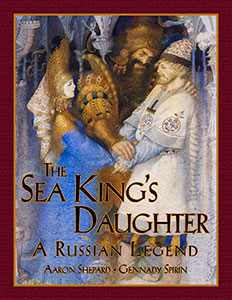Here is the author note from my picture book.—Aaron
In Russia, stories of ancient legendary heroes like the merchant-musician Sadko are preserved in epic ballads known as byliny (pronounced “BIL‑lin‑ee”), a term meaning “what has been.” Originally composed by minstrels between the 10th and 16th centuries, they are recited today by talented peasant “narrators,” mostly in the remote Russian northwest. Reciting is often accompanied by the gusli, a psaltery of twelve or more strings.
Though byliny singing is a dying art, stories drawn from the ballads are known to every Russian schoolchild and form an important part of Russia’s national heritage. Most popular of all is the Sadko legend, made known internationally as well by Rimsky-Korsakov’s opera Sadko.
Sadko’s story is set in Novgorod, the greatest commercial center of medieval Russia. Novgorod was built on both banks of the River Volkhov, a major trade route bringing ships and merchants from Scandinavia, Germany, Greece, Italy, Turkey, Arabia, and Persia. Sadko himself is probably based on the merchant Sotko Sytinich, who in 1167 erected the city’s largest church, according to official chronicles.
Novgorod occupies an important place in Russian political history as well. In 862 it was conquered and made the capital of the Viking prince Rurik, whose heirs founded the Kievan dynasty and ruled most of European Russia until 1598. More importantly, Novgorod became the only medieval Russian city to win independence from princely rule. From 1136 until its conquest by Moscow in 1478, Novgorod was a republic—the closest to a true democracy that any of Russia was to come until the late twentieth century. For Russian visionaries in the centuries between, it became a symbol of liberty.
Russian legend says that every river has its nymph—a female nature spirit in human form who lives in the river and is part of it. And all river nymphs are daughters of the Sea King, into whose waters their rivers flow.
Texts consulted for my retelling include “Folk Tales of Russia,” translated by Kate Blakey, in The Slavonic Review (later The Slavonic and East European Review), Vol. 3; Russian Heroic Poetry, by N. Kershaw Chadwick, Cambridge University Press, Cambridge, 1932; The Heroic Ballads of Russia, by L. A. Magnus, Dutton, New York, 1921; The Epic Songs of Russia, by Isabel Florence Hapgood, Scribners, New York, 1886; Byliny: Heroic Tales of Old Russia, by Alexander Pronin, Possev, Frankfurt, 1971; La Russie Épique, by Alfred Rambaud, Maisonneuve, Paris, 1876; and Sadko: A Lyric Legend (opera libretto), by A. Rimsky-Korsakov, translated by Kathleen de Jaffa, Rullman, New York, 1930.
Additional information on byliny is found in Russian Folklore, by Y. M. Sokolov (sometimes cataloged as I. M. Sokolov), translated by Catherine Ruth Smith, Macmillan, New York, 1950. Historic Novgorod is treated in numerous tourist guides and other references.
